What are sound waves?
Vibration
Sound waves are produced by a vibrating object. Everything that makes a sound must have a part that vibrates.
| Sound of a: | Part that vibrates |
|---|---|
| violin | bowed strings |
| friendās voice | vocal cords |
| guitar | plucked strings |
| school bell | a metal gong hit by a hammer |
| loudspeaker | a cardboard cone inside the loudspeaker |
| tuning fork | metal prongs |
| trumpet | the sound from the trumpet comes from a vibrating column of air created by buzzing lips of the trumpeter |
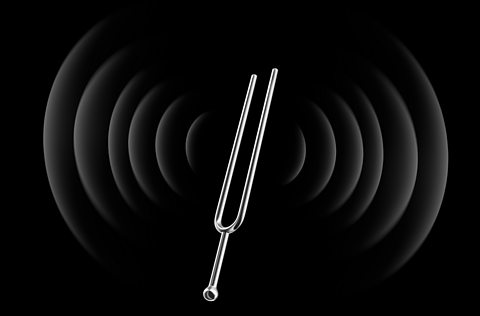
A sound wave is a longitudinal wave. When an object vibrates it produces a longitudinal wave which travels through air to your ear.
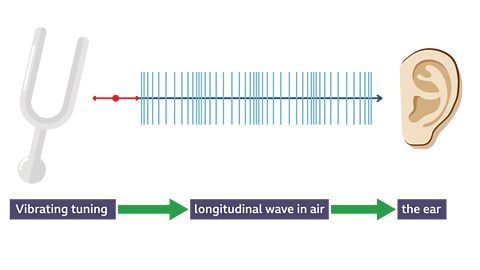
For a sound to be heard you need three things:
- A vibrating object
- A material for the sound wave to travel through, such as air (we call this a medium)
- Something to detect the sound e.g. your ear
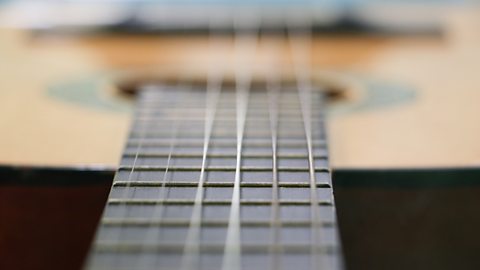
Sound can pass through:
- Solids e.g. sounds will pass through a wall or a glass window
- Liquids e.g. you can hear sounds in a swimming pool when your head is beneath the water
- Gases e.g. sound passes through air
Loudspeakers
Sound waves are produced by all vibrating objects. Loudspeakers work by converting electrical energy into kinetic energy. This vibrates the cone which creates the sound waves.
Engineers show us the key components in a loudspeaker and explain how they work
A two-minute video showing you how to make a speaker from wire, a cup and a magnet.
Echoes
Sound waves can reflect off surfaces. We hear reflected sound as an echo. Hard, smooth surfaces are particularly good at reflecting sound. This is why large, empty rooms produce lots of echoes.
Soft, rough surfaces are good at absorbing sound. This is why rooms with carpets and curtains do not usually produce lots of echoes. People in a room will help to absorb sound too. The sound made by a band is very different in an empty concert arena than when it is full.
A case study video on how a producer applies the concept of sound waves to their job.
“óĻó“«Ć½ Radio sound engineer Tom Parnell talks about the different microphones and speakers used for recordings at the “óĻó“«Ć½'s MediaCityUK studios in Salford
The ear
Our ears have two important functions:
- To collect sounds, convert them to electrical signals and send them to the brain
- To maintain our sense of balance
The ear is made up of three different sections that work together: the outer ear, the middle ear, and the inner ear.
Outer ear
- Parts - pinna and ear canal
- Job - collecting sounds
The eardrum separates the outer ear from the air-filled middle ear. Sound waves make it vibrate.
Middle ear
- Parts - hammer, anvil and stirrup
- Job - to pass vibrations from the eardrum to the inner ear
Inner ear
- Parts - cochlea and semi-circular canals
- Job - to convert the vibrations from the middle ear into nerve signals and to help you balance
A narrow tube called the eustachian tube runs from the middle ear to the back of the nose and makes sure that the pressure is the same on both sides of the eardrum.
When your ears pop the eardrum moves back into place, easing any pressure difference, and making you feel more comfortable. The eustachian tube can open automatically when you swallow, blow your nose or yawn. When you do these motions, you'll often hear a clicking or popping sound.
| Part of the ear | What it does |
|---|---|
| Pinna | This is the outer flap of the ear ā the part you see on the side of your head. Its main job is to gather sound waves and funnel them towards the ear canal. They are quite good for hanging spectacles and sunglasses on too. |
| Ear Canal | The pathway for the sound wave to the ear drum and the middle ear. |
| Eardrum | A thin, cone shaped piece of tissue stretched tight across the end of the ear canal. Sound waves make the ear drum vibrate. |
| Hammer, Anvil, Stirrup | Three small bones which pass on vibrations from the eardrum to the cochlea. The eardrum is attached to the hammer which is attached to the anvil which is attached to the stirrup. The stirrup is the smallest bone in the body. |
| Cochlea | The snail-shaped cochlea changes the vibrations from the middle ear into nerve signals. These signals travel to the brain along the auditory nerve. |
| Auditory nerve | Electrical signals travel from the cochlea to the brain along the auditory nerve. |
| Semi-circular canals | To help you balance. They play no part in hearing. |
How we hear:
- a sound wave is funnelled into the ear canal by the pinna
- the vibrations in the air make the eardrum vibrate
- these vibrations are passed through the three small bones (called ossicles) to a spiral structure called the cochlea
- electrical nerve signals are passed from the cochlea to the brain through the auditory nerve
- our brain interprets these signals as sound
The energy changes in the ear are:
How we hear
Properties of sound
The frequency of a sound wave is related to the pitch that is heard:
- a high frequency sound wave has a high pitch;
- a low frequency sound wave has a low pitch.
The amplitude of a sound wave is related to the volume of the sound:
- large amplitude sound waves are loud;
- small amplitude sound waves are quiet.
Amplitude and frequency can be displayed on an oscilloscope connected to a microphone
Oscilloscope traces showing the following sounds:
- Trace 1. small amplitude, low frequency ā a quiet, low pitch sound.
- Trace 2. large amplitude, low frequency ā a loud, low pitch sound.
- Trace 3. large amplitude, high frequency ā a loud, high pitch sound.
Frequency and amplitude
The speed of sound
The speed of sound in air can measured using two wooden blocks, a tape measure or trundle wheel and a stopwatch:
- two people (person A and person B) are placed a distance apart, e.g. 200 m
- person A bangs two wooden blocks together
- person B starts a stopwatch on seeing the blocks bang together and stops the stopwatch on hearing the sound
- the time taken for the sound to travel from A to B is recorded in the table
- repeat the procedure ten times and calculate an average time
The speed of sound can be calculated using the equation:
Speed \( = \frac{{distance,travelled}}{{time,taken}}\)
For example, two people are 200 m apart. The average time for sound to travel the 200 m between them is measured to be 0.59 s
Speed \( = \frac{{distance,travelled}}{{time,taken}}\)
Speed = 200 Ć· 0.59 = 339 m/s
Using microphones and data logger
To measure the speed of sound in the lab, a much more accurate timing method is required because the distance travelled by the sound is much shorter. This can be achieved using a data logger
The data logger can measure and record the time taken for sound to travel between two microphones. Unlike the wooden block method, these can be quite close together.
For example, two microphones are 3.4 m apart. The data logger recorded a time of 0.01 s for the sound to travel between the microphones.
Speed \( = = \frac{{distance,travelled}}{{time,taken}}\)
Speed = 3.4 Ć· 0.01 = 340 m/s
The speed of sound is often taken to be 340m/s in air, but it varies depending on temperature and air pressure. 340 m/s is about 760 miles per hour.
Sound travels faster through liquids and solids than it does through air and other gases. The table gives some examples.
| Substance | Speed of sound |
|---|---|
| Air | 340 m/s |
| Water | 1500 m/s |
| Steel | 5130 m/s |
This is because the particles of gases are further apart than liquids or solids. Sound waves travel more slowly when particles are further apart.
Can sound travel through a vacuum?
Sound can travel through solids, liquids and gases, but can it travel through a vacuum?A simple experiment will give us the answer.
Connect an electric bell to a battery and switch. Close the switch and listen to it ring.
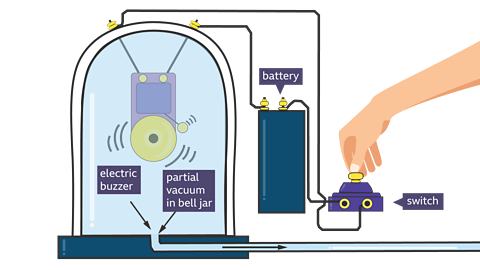
Now place the bell inside a glass jar, called a bell jar, as shown above. Make sure it is tightly sealed at the bottom and connect to a vacuum pump. Stand behind a safety screen.
Close the switch again and listen to the ring. You should notice that it is not as loud, but you are still able to hear it.
Keep the bell ringing and turn on the vacuum pump. Make sure the safety screen remains between you and the bell jar. Listen carefully as the vacuum pump removes the air from inside the jar.
You will notice that as air is removed, the ringing sound gets quieter and quieter, until you cannot hear it at all. You can still see the bell hammer hitting the gong, so you know the bell is ringing, but the sound is not reaching you.
Let the air slowly back into the jar. You will notice that you start to hear the bell again.
Conclusion
- when the jar is placed over the bell it is quieter because the jar muffles some of the sound
- when the air is removed from the jar you cannot hear the sound because sound needs something to travel through
- we can still see the bell in the jar, which tells us that light passes through a vacuum
The experiment shows that sound can travel through gases (air), through a solid (glass), but it cannot travel through a vacuum. Light however, does pass through a vacuum
We say that:
- sound cannot travel through a vacuum; it needs a medium to travel through.
Sound does not travel through space because space is a vacuum. If you shouted in space nobody would hear you.
An investigation into how sound travels through the air. An alarm clock is placed in a special jar. As the air inside the jar is pumped out, the alarm bell becomes quieter and quieter. When the air has been completely emptied from the jar, the bell can't be heard at all, although it is still ringing. The air is allowed back into the jar and the bell can then be heard again.
Ultrasound
As we saw earlier in this topic human beings can generally hear sounds as low as 20 Hz and as high as 20 000 Hz (20 kHz).
Any sound above 20 000 Hz is called ultrasound. It is too high pitched for humans to hear, but other animals (such as dogs, cats, dolphins and bats) can hear ultrasound.
Ultrasound waves are longitudinal waves just like sound waves, and they cannot pass through a vacuum. Ultrasound waves have a frequency above 20 000 Hz, other than that they are like sound waves in every other way.
Ultrasound has many applications in medicine, including ultrasound scans to check on the health of unborn babies.
Scans of foetuses (unborn babies developing in the womb) are made this way and are used, for example, to measure the diameter of the head of a foetus so that growth can be monitored.
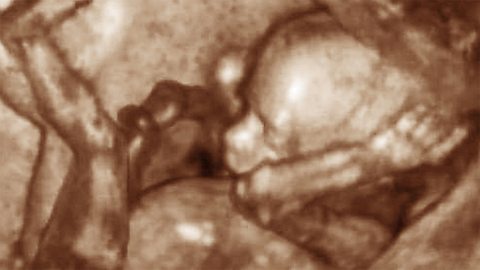
Ultrasound images can also be used to help find problems with:
- heart
- kidneys
- blood vessels
- bladder
Doctors like using ultrasound images because:
- ultrasound does not harm the patient, mother or foetus in any way
- images of internal organs like the heart can be seen without having to operate on patients
- the equipment is easy to use and relatively cheap
Echo sounding
High frequency ultrasound waves can be used to detect objects in deep water and to measure the depth of the sea. Ultrasound is reflected off an object in the sea or from the seabed, and the echo is detected.
This technique is applied in sonar systems used to measure the depth of the seabed and to find shipwrecks, submarines and shoals of fish. The time between a pulse of sound being transmitted and detected (its echo), and the speed of sound in water are used in the calculation.
SONAR stands for SOund Navigation And Ranging.
One of the reasons for using ultrasound for sonar is that humans using the water for swimming or diving donāt hear it and so are not disturbed.
Bats and dolphins use a similar method, called echolocation, to detect their surroundings and to find food.
Example
A sonar system on a boat sends an ultrasound pulse towards the seabed.The pulse is reflected, and it is detected 0.16 s later by the system.
Calculate the depth of water if the speed of sound in water is 1 500 m/s.
Answer
distance = speed Ć time
speed = 1 500 m/s
time for ultrasound to travel to seabed and back again = 0.16 s
We are calculating the depth of the seabed, so we only need the time for the ultrasound to travel to the seabed (be careful to remember this part of the calculation)
time for the ultrasound just to travel to the seabed = 0.16 s Ć· 2 = 0.08s
distance to seabed = 1 500 Ć 0.08 = 120 m
The depth of water is 120 m.
Noise and damage to the ear
We are subjected to sounds pretty much all the time. Many sounds are nice, and we enjoy them. But what is nice to you might not be so nice to somebody else who is also hearing the sound.
Noise is unwanted sound

Noise doesnāt have to be loud sound ā it just has to be unwanted. Chattering quietly in a library is noise, as is loud music played from a smart speaker on the beach, if it disturbs other users.
When the sound level of noise rises to higher levels, we refer to this as noise pollution.
Noise can be irritating and annoying, but it can also cause tiredness, loss of concentration or even damage hearing
Sound levels and damage to hearing
Sound levels are measured on a scale known as the decibel scale (dB). The higher the number the greater is the sound level.
| Source of Sound | Sound level in decibels |
|---|---|
| the threshold of sound | 0 |
| a whisper | 20 |
| a quiet walk in the country | 30 |
| a quiet living room | 40 |
| normal conversation | 60 |
| busy traffic | 80 |
| motor bike | 90 |
| pneumatic drill - 5 metres away | 100 |
| at the front of a pop concert | 120 |
| threshold of pain | 140 |
Sound level can be measured with a device called a decibel meter. It samples and measures sound, giving a readout. Decibel meters (also called sound-level meters) can even be accessed on a smartphone through apps. Measuring the sound level with a smartphone may help protect your hearing.If the sound level is too high, hearing can be damaged.
- Sound levels above 70 dB over a long period of time may start to damage your hearing
- Hearing 90 decibel sound levels for a long time can cause permanent hearing loss
- Loud noise above 120 dB can cause immediate harm to your ears.
- Hearing a brief sound level of 140 decibels will cause pain and can cause permanent damage to hearing
Eighty-five decibels is considered the highest safe sound level for up to a maximum of eight hours. The time for safe listening decreases as sound levels increase.For example, a sound as high as 100 dB can be safely listened to for only 15 minutes each day.
- users of earphones usually choose to set the volume between 75 to 105 dB
- at nightclubs and discos the average sound levels can range from 104 to 112 dB
- sound levels at pop concerts may be even higher
Even a short duration of exposure to high-decibel levels such as these can be harmful. Doing it regularly will almost certainly lead to hearing loss over time.
The good news is that noise-induced hearing loss can be prevented by following safe listening.
Make listening safe by:
- keeping the volume down ā have the volume so you can hear your music comfortably, but no higher
- use noise-cancelling earphones or headphones ā do not just turn the volume up to cover up outside noise
- limit the use of earphones to no more than an hour at a time
- move away from loudspeakers at noisy venues and try to take a break from the loud sound every 15 minutes
- always wear ear protection when using noisy machinery
You can easily damage your ears without knowing it.
Summary: sound
- sound waves are longitudinal
- sound waves are produced by a vibrating object
- sound can travel through solids, liquids and gases
- sound cannot travel through a vacuum ā it needs a medium to travel through
- the speed of sound in air is approximately 340 m/s
- a high frequency sound wave has a high pitch
- large amplitude sound waves are loud
- reflected sound is called an echo
- the range of human hearing is 20 Hz to 20 000 Hz
- sound waves with a frequency above 20 000 Hz are called ultrasound
- eighty-five decibels is considered the highest safe sound level
More on Physics
Find out more by working through a topic
- count4 of 8

- count5 of 8

- count6 of 8

- count7 of 8
